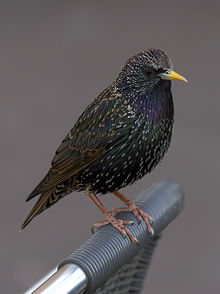Neoaves: Difference between revisions
Appearance
Content deleted Content added
| Line 22: | Line 22: | ||
One hypothesis for the [[phylogeny]] of [[modern birds]] was presented by Prum, R.O. ''et al''. (2015)<ref name=Prum2015>Prum, R.O. ''et al''. (2015) [http://www.nature.com/nature/journal/v526/n7574/full/nature15697.html A comprehensive phylogeny of birds (Aves) using targeted next-generation DNA sequencing]. Nature 526, 569–573.</ref> The following [[cladogram]] illustrates the proposed relationships, with some taxon names following Yury, T. ''et al.'' (2013)<ref>Yuri ''et al.'' (2013) [http://www.mdpi.com/2079-7737/2/1/419 Parsimony and Model-Based Analyses of Indels in Avian Nuclear Genes Reveal Congruent and Incongruent Phylogenetic Signals]. ''Biology'', 2(1):419-444. doi:10.3390/biology2010419</ref> and Kimball et al. 2013.<ref>Kimball, R.T. ''et al.'' (2013) Identifying localized biases in large datasets: A case study using the Avian Tree of Life. ''Mol Phylogenet Evol''. doi:10.1016/j.ympev.2013.05.029</ref> |
One hypothesis for the [[phylogeny]] of [[modern birds]] was presented by Prum, R.O. ''et al''. (2015)<ref name=Prum2015>Prum, R.O. ''et al''. (2015) [http://www.nature.com/nature/journal/v526/n7574/full/nature15697.html A comprehensive phylogeny of birds (Aves) using targeted next-generation DNA sequencing]. Nature 526, 569–573.</ref> The following [[cladogram]] illustrates the proposed relationships, with some taxon names following Yury, T. ''et al.'' (2013)<ref>Yuri ''et al.'' (2013) [http://www.mdpi.com/2079-7737/2/1/419 Parsimony and Model-Based Analyses of Indels in Avian Nuclear Genes Reveal Congruent and Incongruent Phylogenetic Signals]. ''Biology'', 2(1):419-444. doi:10.3390/biology2010419</ref> and Kimball et al. 2013.<ref>Kimball, R.T. ''et al.'' (2013) Identifying localized biases in large datasets: A case study using the Avian Tree of Life. ''Mol Phylogenet Evol''. doi:10.1016/j.ympev.2013.05.029</ref> |
||
{{clade| |
{{clade|style=font-size:80%;line-height:95% |
||
|label1='''Neoaves''' |
|label1='''Neoaves''' |
||
|1={{clade |
|1={{clade |
||
|1={{clade |
|1={{clade |
||
|label1=[[Strisores]] |
|label1=[[Strisores]] |
||
|1={{clade |
|1={{clade |
||
|1=[[Caprimulgidae]] (nightjars) |
|1=[[Caprimulgidae]] (nightjars) |
||
|2={{clade |
|2={{clade |
||
| Line 67: | Line 67: | ||
|2=[[Pteroclidiformes]] (sandgrouse)[[File:Pterocles quadricinctus white background.jpg|40 px]] |
|2=[[Pteroclidiformes]] (sandgrouse)[[File:Pterocles quadricinctus white background.jpg|40 px]] |
||
}} |
}} |
||
}} |
}} |
||
}} |
}} |
||
}} |
}} |
||
|label2= |
|label2= |
||
Revision as of 18:30, 15 August 2018
| Neoavians | |
|---|---|

| |
| Common starling (Sturnus vulgaris) | |
| Scientific classification | |
| Domain: | Eukaryota |
| Kingdom: | Animalia |
| Phylum: | Chordata |
| Class: | Aves |
| Infraclass: | Neognathae |
| Clade: | Neoaves Sibley et al., 1988 |
| Clades | |
Neoaves is a clade that consists of all modern birds (Neornithes or Aves) with the exception of Paleognathae (ratites and kin) and Galloanserae (ducks, chickens and kin). The early diversification of the various neoavian groups occurred very rapidly around the Cretaceous–Paleogene extinction event,[2] and attempts to resolve their relationships with each other have resulted initially in much controversy.[3][4]
Phylogeny
One hypothesis for the phylogeny of modern birds was presented by Prum, R.O. et al. (2015)[5] The following cladogram illustrates the proposed relationships, with some taxon names following Yury, T. et al. (2013)[6] and Kimball et al. 2013.[7]
{{clade|style=font-size:80%;line-height:95% |label1=Neoaves
|1=
References
- ^ Van Tuinen M. (2009) Birds (Aves). In The Timetree of Life, Hedges SB, Kumar S (eds). Oxford: Oxford University Press; 409–411.
- ^ Claramunt, S.; Cracraft, J. (2015). "A new time tree reveals Earth history's imprint on the evolution of modern birds". Sci Adv. 1 (11). doi:10.1126/sciadv.1501005. PMC 4730849. PMID 26824065.
- ^ Mayr G. (2011) Metaves, Mirandornithes, Strisores and other novelties - a critical review of the higher-level phylogeny of neornithine birds. J Zool Syst Evol Res. 49:58-76.
- ^ Matzke, A. et al. (2012) Retroposon insertion patterns of neoavian birds: strong evidence for an extensive incomplete lineage sorting era Mol. Biol. Evol.
- ^ Prum, R.O. et al. (2015) A comprehensive phylogeny of birds (Aves) using targeted next-generation DNA sequencing. Nature 526, 569–573.
- ^ Yuri et al. (2013) Parsimony and Model-Based Analyses of Indels in Avian Nuclear Genes Reveal Congruent and Incongruent Phylogenetic Signals. Biology, 2(1):419-444. doi:10.3390/biology2010419
- ^ Kimball, R.T. et al. (2013) Identifying localized biases in large datasets: A case study using the Avian Tree of Life. Mol Phylogenet Evol. doi:10.1016/j.ympev.2013.05.029

